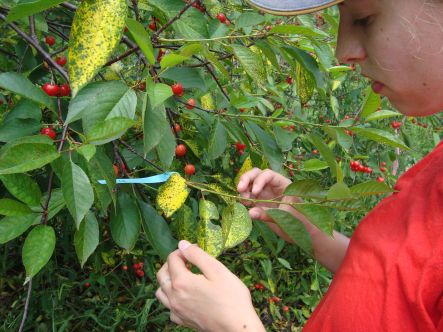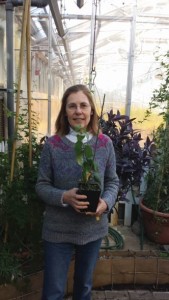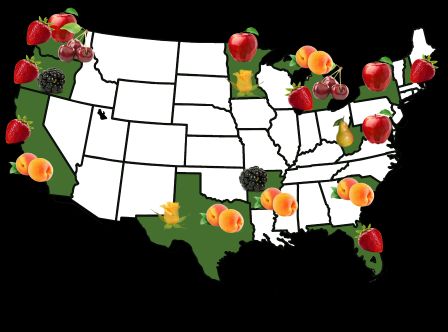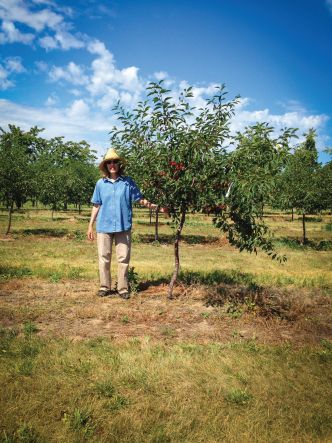RosBREED: A National Effort To Improve The Fruit Industry

Cherry leaf spot is an example of a disease that RosBREED is targeting.
Perhaps the biggest problem in the U.S. fruit industry over the past half-century or so is that the various players have had different needs — needs that unfortunately have been in direct conflict.
First off, the modern large-scale commercial grower has had to be able to produce fruit that can be shipped long distances over long periods of time. If by the time that fruit is unpacked and put on the shelves in the produce aisle it doesn’t look good, and it won’t sell. Some people argue consumers don’t buy with their eyes as much as the produce buyers have traditionally believed — often with good reason — but ugly spots or other discoloration certainly wasn’t going to cut it.
Of course, that meant a lot of fruit was picked and shipped under-ripe when it was hard enough to survive the long voyages. Anybody who enjoys a great piece of fruit knew this system was broken, but what else to do? Everyone also knew, for example, the first cherries shipped to Asia were usually the most tasteless — but they also commanded the highest prices.
Then in 2009, along came RosBREED, a national USDA-NIFA-Specialty Crop Research Initiative–funded program to produce great-tasting fruit that resisted storage problems and other maladies. Genomic knowledge of rosaceous crops — such as apple, cherry, peach, pear, strawberry, and roses, as well as blackberry, peach and cherry rootstocks — had grown to the point that such cultivars could be developed, but such a national effort was required.

Project Director Amy Iezzoni (Photo Credit: Michigan State University)
Shift To Disease Resistance
Progress was made in fruit quality, but in recent years it became clear that more disease resistance was necessary as well, says RosBREED Project Director Amy Iezzoni of Michigan State University. For instance, ‘Golden Delicious’ apples and diploid strawberries had been genetically sequenced, but the work wasn’t really helping fruit breeders.
“It’s easy to sequence something, but to apply it practically is another challenge,” she says. “We needed that a practical benefit for our industry.”
When initial funding ended, RosBREED II was launched in 2015. Though a lot of work had been done over the years in developing disease disease-resistant varieties and varieties with great horticultural quality, getting both of those things together had been somewhat elusive.
The program is using advanced breeding and DNA techniques — but not controversial GMO technology — that will allow breeders to cut years and thousands of dollars from the process of creating and evaluating crosses that will potentially lead to valuable new commercial varieties.
“We can reduce the negative impact of diseases, but it is critical to deliver varieties that result in a reduced spray bill but also have the consumer-desired fruit quality,” says Iezzoni. “We have a lot more capability to breed more precisely.”
What tangible results might growers enjoy in the next few years? Iezzoni says growers might very well see:
– Honeycrisp’ apples without storage problems
– Peaches with better tolerance to chilling damage
– Both earlier and later sweet cherry varieties
– Reduced crown and root rot in strawberries
– Limiting Armillaria root rot in peaches and cherries

RosBREED will have an impact on nearly all the major U.S. rosaceous crop production areas.
Industry Weighs In
Besides all the fruit breeders and academics that make up RosBREED II, there are three advisory panels representing industry, scientific, and Extension interests. Panel members broadly represent the diversity of Rosaceae by crop, region, and professional expertise. (Editor’s note: In the interest of full disclosure, American Fruit Grower® and Western Fruit Grower® magazines are represented on these advisory panels.)
Following the recent annual Advisory Panel meeting, held each January in San Diego, CA, some of the members were surveyed as to their thoughts on RosBREED. Those answering included:
- Chris Britton, Britton Konynenburg Partners, a grower of apples and other crops in Modesto, CA, and a former president of the USApple Association’s Board of Trustees
- Jim Allen, president of the New York Apple Association in Fishers, NY
- Philip Korson, president of the Cherry Marketing Institute in Lansing, MI
- Bruce Grim, director of the Washington Marketing Association in Wenatchee, WA
Peter Hirst, a professor in the Department of Horticulture at Purdue University in West
Lafayette, IN - Why should growers be interested in RosBREED?
- Hirst: Growers are pretty interested in where the new apple cultivars may be coming from. This interest is what drove some Midwestern growers to form the Midwest Apple Improvement Association (MAIA). Growers are also very interested in reducing pesticide use and recognize that new cultivars with genetic resistance offer a lot of potential to reduce the amount of pesticides that need to be used.
- Grim: Growers are interested in planting the next variety that will reprise the ‘Honeycrisp’ story . The best way to get there is to speed the process of new variety development by using marker-assisted breeding techniques that will allow for the extraction of genetic material to determine of if the genome contains the desired parentage. If it does not, there is no need to continue growing those seedlings that we now know will not contain the traits we are looking for. Given the retailer and consumer desire for something new and different, this is an effective means of speeding up the process.
- Korson: For cherry this is an exciting opportunity. It will speed up the traditional breeding process and improve the varieties that growers will have available in the future. Cherry leaf spot and Armillaria root rot are huge problems for our industry. RosBREED II is laser-focused on the two major challenges. For the next-generation fruit grower this is huge!
- Allen: RosBREED has yet to really reach the grower level for the grass roots to fully understand and appreciate the efforts that are being made, at least for deciduous fruit. Since nothing has yet been “released” or placed into commercial application, it is hard for the public to see the benefits.
- Britton: Traditional tools are being lost. RosBREED’s success will enable horticulturists to produce apples, cherries, peaches and other rosaceous crops more efficiently and profitably while giving customers a product that requires fewer traditional inputs.

Members of the RosBREED team and some of the advisors at the annual advisory panel meeting this past January is San Diego, CA. (Photo Credit: Mercy Olmstead)
What is RosBREED’s chief value?
Hirst: Projects like RosBREED obviously address the project objectives, but they also bring scientists and industry personnel together. This leads to brainstorming industry needs and sometimes out-of-the-box thinking. While the benefits of this cooperation and collaboration may be difficult to quantify, there is no doubt that it is of value and leads to future collaborations. Also, it’s a lot of fun to be involved in projects like this.
Grim: Through genome mapping of Rosaceae, we know the location of many of the traits we are seeking to enhance through the cross-breeding process. Think of the time and money saved by knowing that a significant portion of your test seedlings do not contain the desired genetic traits. We now no longer have to go to the time and expense of raising all the seedlings to be able to phenotype the desired traits.
Korson: Its major value is the ability to focus on the needs of growers. RosBREED I and II have done just that. In our industry the work Dr. Iezzoni is doing is strongly supported. We also support the collaborative sharing of information from breeders all over the world. Bringing together a team of this caliber does not just happen. RosBREED has been successful in doing that and the progress to date has been impressive.
Allen: The chief value in my mind will be getting a jump on breeding and being able to reduce the time it takes to isolate and to propagate a beneficial trait in apples.
What difference will RosBREED make in the coming years to the fruit industry?
Hirst: RosBREED has a high likelihood of success. Success will mean the development of tools that allow breeders to develop new, high quality cultivars with durable disease resistance.
Grim: What I have discussed above is the result of RosBREED I; RosBREED II is seeking to look at crosses that will highlight disease prevention by looking at the genetic level for strains that are resistant to fire blight, apple scab, mildew, and such. That is exciting stuff. Imagine the reduced costs associated with less pesticide usage! We could likely see an increase in organic production around the country if fungicide use could be curtailed by breeding resistant strains of trees. RosBREED can significantly reduce the time needed to breed the new strains and get them in production and the fruit into consumers’ hands more quickly than conventional breeding methods.
Korson: I really believe the tart cherry industry is on the cusp of new disease-resistant varieties that will change the way we manage our crop. Disease resistance is huge for us and with our climate, one of the cost drivers in our annual production. We also know we will discover things along the way. That’s how science works and we are excited about that as well.
Allen: As stated, if it can shorten the time from 16-22 years to 8-11 to release a new variety or an improved variety, offering beneficial growing, production, and consumer benefits, this would be an enormous cost savings to the industry, as well as a commercial advantage in the world market.
What will consumers get out of it? How about growers?
Hirst: New cultivars with durable disease resistance will benefit growers by reducing their costs and delay the development of resistance to pesticides. Consumers will benefit by having new high quality fruit that is produced in a more sustainable manner.
Grim: Consumers may want to know that this is not genetic engineering or the creation of GMO products. Those who fear GMO products appear to be undeterred by sound science but RosBREED takes away the discussion by making the issue moot. The most exciting thing about RosBREED II is potential reduction in the incidence of fire blight, mildew, scab and a host of diseases by breeding strains resistant to damage at the genetic level. Fruit quality and disease prevention are the key components of the program.
Korson: Consumers get high high-quality fruit that meets their needs. It will also reduce our need to spray and this is a positive with consumers. Tart cherry farmers are strong believers in IPM and this becomes a new tool in our tool box which will be a big deal for our farmers.
Allen: Hopefully growers will get better crosses, quicker and more cheaply. Consumers will be delighted with the results, and will consume more fruits.
SIDEBAR:
‘Amy Appleseed’
 Back in the 19th Century, a fellow by the name of John Chapman traveled the Eastern and Midwestern U.S., dispensing seeds and planting so many apple trees he earned the legendary moniker “Johnny Appleseed.”
Back in the 19th Century, a fellow by the name of John Chapman traveled the Eastern and Midwestern U.S., dispensing seeds and planting so many apple trees he earned the legendary moniker “Johnny Appleseed.”
RosBREED II Project Director Amy Iezzoni shares something in common with Chapman, but instead of packing seeds on her frequent travels, she packs the actual fruit. Instead of planting seeds, she’s planting ideas.
“I take fruit wherever I go,” she says. “People experience qualities they never have; it’s a totally new thing for them.”
For example, there’s the huge, as-yet unnamed cherry variety with a freestone pit that’s like that of an apricot. “It comes out so easily,” she says. “It’s really an amazing trait.”
Iezzoni says RosBREED’s goals of increasing fruit quality while lessening disease — thus increasing storage life and reducing input costs — aren’t so difficult to sell to growers. But true success requires consumer buy-in on a large scale. That too, though, is just a matter of time, she believes, citing the large freestone cherry as an example.
“These wonderful new traits occur all the time (in breeding materials),” she says, “but we haven’t gotten them into modern varieties.”
But to be able to share them, she has to do it the old-fashioned way. Social media is incredibly useful, Iezzoni says, but not in this particular instance.
“Fruit can’t be tweeted,” she says with a smile, “it must be eaten.”









